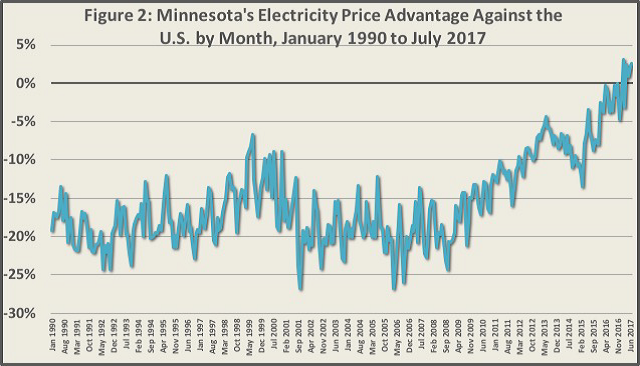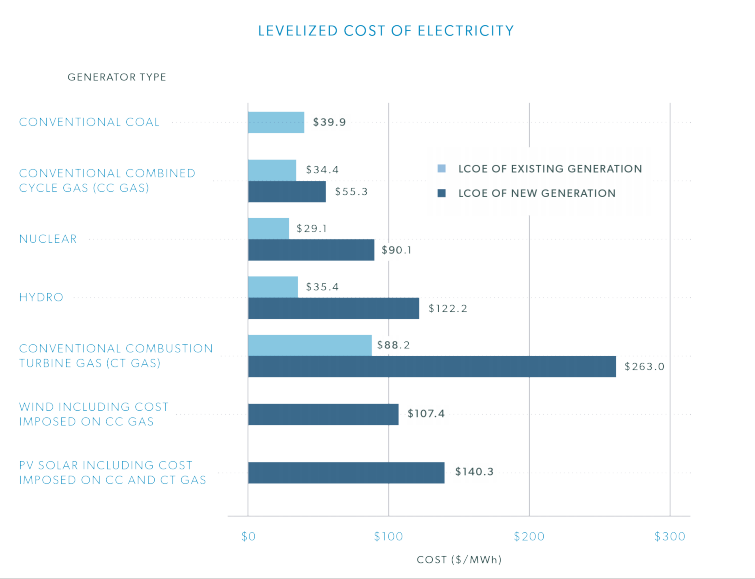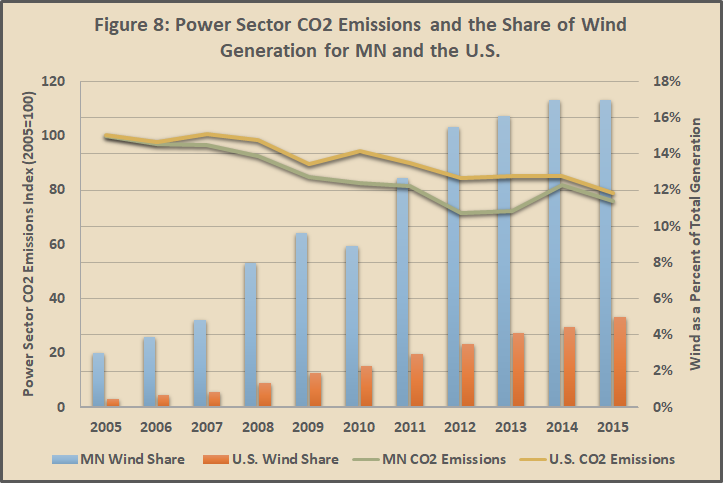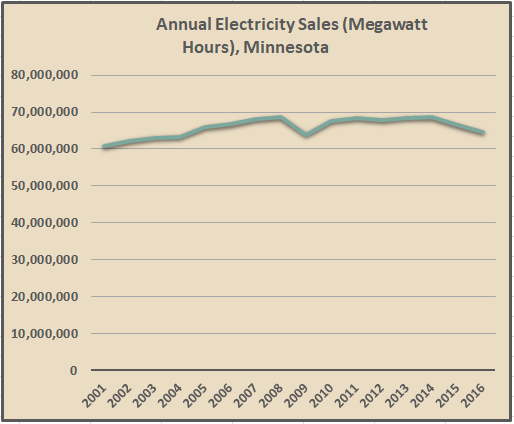American Experiment Responds to Critical Energy Post
Last week I wrote a blog post critiquing a poll conducted by the Minnesota Conservative Energy Forum (MnCEF). MnCEf wrote a response to my post, which you can read here. There were several problematic assertions in their response, so I have written this post to rebut these claims and correct factual errors.
This is not meant to be an attack on that organization. Rather, this post is for conservative and free-market Minnesotans to engage in a healthy dialogue and gain a better understanding of how our energy system works.
In short, this post will cover four main points:
1) As free-market advocates, we do not have an ideological preference for any particular fuel, but we do have a strong ideological preference for customer value. Unfortunately, wind and solar are a poor value for Minnesota electricity consumers.
2) Claims that unsubsidized wind is cheaper than conventional fuels are false.
3) Pollution controls on traditional power plants have delivered clean air at a superior value to Minnesota consumers.
4) Promoting renewable energy does not negatively impact monopoly utility companies, it enriches them at the expense of Minnesota families.
1) We Promote Consumer Value, Not Specific Technologies
As free-market advocates, we do not have an ideological preference for any particular fuel, but we do have a strong ideological preference for customer value. Unfortunately, wind power is a poor value for Minnesota electricity consumers.
Minnesota has spent approximately $15 billion on wind energy, and this has resulted in increasing electricity prices. In fact, Minnesota used to have electricity rates far below the national average, now, we are above the national average, as show in the diagram below.

Electricity prices have increased in Minnesota because on average, electricity generated from wind power is 2.69 times more expensive than using existing coal plants, 3.12 times more expensive than existing natural gas plants, and 3.69 times more expensive than existing nuclear power. Solar fares even worse, as shown in the figure below.

As it stands today, natural gas, nuclear, and coal deliver the most reliable, and lowest-cost electricity. These sources of electricity are able to churn out cheap electrons at a steady pace, whereas wind and solar are intermittent, and only able to generate electricity when the wind is blowing or the sun is shining.
The intermittency of wind and solar presents a problem because the supply of electricity must be carefully calibrated to meet demand at all times, otherwise, having too much or too little electricity on the grid could result in blackouts or damage to the grid.
Because it is difficult to predict when wind or solar will provide electricity, other forms of electricity generation, such as natural gas or coal, must be ready to increase their output of electricity when the wind dies down and decrease their output when wind or solar are producing electricity. This is called “load balancing.”
Load balancing increases the cost of electricity because natural gas or coal plants must be ready to generate electricity when needed, meaning they cannot be shut down. Think of this in terms of needing two power plants running to provide the electric output of one power plant.
Additionally, coal and natural gas plants have high fixed costs like paying their employees, performing maintenance, and financing their debt (their mortgage, so to speak), and these fixed costs far outweigh any savings they may have from burning less fuel.
This means having to accommodate wind energy imposes a net cost on these power plants, and this cost is passed on to consumers, which is partially why electricity prices have increased in Minnesota.
Because load balancing is primarily used to accommodate intermittent sources of energy, these costs should be attributed to it wind and solar, not other sources of electricity.
Key Takeaway
Advocating for any fuel source (such as coal or oil) at “any cost” would be a foolish endeavor, but advocating for the sources of energy that happen to provide the most cost-effective means of meeting our electricity needs is something all conservatives should value.
Given that existing coal, natural gas, and nuclear plants are decidedly more affordable than wind or solar, a better strategy for conservatives would be to advocate for utility companies to explore upgrading their existing coal plants like Sherco, and renewing the licenses on their nuclear plants, rather than shutting down these sources of electricity and building more-expensive, new power plants.
If these units must be shut down and replaced, new natural gas is a much more cost-effective option than renewables.
2) Claims that unsubsidized wind is cheaper than conventional fuels are false.
Some renewable energy advocates like to pretend that unsubsized wind is cost effective with conventional sources of energy.These advocates cite a study by Lazard, but this study has two main problems: 1) it does not account for the cost of load balancing, which was discussed above, and 2) it does not take the cost of transmission lines into account.
1) Load balancing was not addressed
Load balancing is a crucial component of the electricity debate, but the Lazard study explicitly does not address this in their study.
In fact, the Lazard study has this large disclaimer:
“Although alternative energy is increasingly cost-competitive and storage technology holds great promise, alternative energy systems alone will not be capable of meeting the base-load generation needs of a developed economy for the foreseeable future. Therefore, the optimal solution for many regions of the world is to use complementary conventional and alternative energy resources in a diversified generation fleet [emphasis added].”
One can only claim alternative energy is cost competitive with conventional sources if one does not acknowledge that these conventional sources are needed to provide electricity when the wind is not blowing or the sun is not shining. As discussed above, this is flat-out incorrect, and conservatives need to know that these claims come with enormous caveats.
We must base our electricity policy based on the real-world factors that affect the cost of electricity, not on a study that does not account for these very real costs.
2) Transmission lines are expensive
A recently-constructed transmission line in South Dakota cost $140 million for a 70-mile line. This cost equates to approximately $2 million per mile of transmission line that was used almost exclusively to transmit wind energy.
Minnesota has already paid a high cost for transmission lines. According to Xcel Energy’s Renewable Energy Rate Impact Report, Xcel has spent $1.8 billion to build the transmission lines needed to comply with Minnesota’s Renewable Energy Standard. Assuming a similar cost to the rest of Minnesota’s utilities means wind energy has cost the state roughly $4 billion dollars in transmission lines alone.
Additional transmission lines needed to connect wind projects such as the proposed 50-mile Huntly-Wilmarth Project could roughly cost the state an additional $100 million.
3) Pollution controls on coal-fired power plants have resulted in clean air while delivering superior value on the electricity provided relative to wind energy.
Air monitoring data from the Minnesota Pollution Control Agency (MPCA) show that the air has gotten significantly cleaner since 1990, and all measured pollutants are below the lowest, most-protective standards for air quality established by regulatory agencies.

The improvements in air quality happened at a time when Minnesota burned more coal than today, and when wind power provided an insignificant amount of the electricity generated in the state.
For example, coal was used to generate 65.4 percent used to generate electricity in 1990, and it still generated 58 percent of electricity during 2008. However, during this time, emissions of carbon monoxide, nitrogen dioxide, fine particles, and PM10 fell dramatically.
This data proves we can have clean air while still using more-affordable natural gas and coal for electricity generation.
The only compound that wind or solar could theoretically reduce in a meaningful way relative to coal or natural gas would be carbon dioxide, but our research at American Experiment shows that this so-called attribute of wind energy is, overblown.

Carbon dioxide emissions have fallen in Minnesota, but other states have reduced their emissions by nearly the same amount by using more affordable natural gas at a fraction of the cost of wind.
Conservatives care about clean air and clean water. That is exactly why they need to know that advanced pollution controls make our current sources of energy clean, while also providing the most cost-effective forms of electricity.
Minnesotans can have clean and cheap energy, but not if we have wind power.
4) Promoting renewable energy does not negatively impact monopoly utility companies, it enriches them at the expense of Minnesota families.
Many people do not realize that electric utility companies like Xcel Energy are not really private companies, they are more like quasi-private, government-approved monopolies. These utilities are guaranteed to make a profit, so they do not have to worry about losing money if they make bad investments like normal businesses would.
This guaranteed profit incentivizes utility companies to build power plants whether they are needed or not. Thus, rather than posing a chance to lose money on a bad investment, wind energy allows utility companies to grow their profits.
In fact, monopoly utility companies are probably delighted to have renewable energy mandates because they earn a 10 percent profit of every dollar spent on infrastructure. Renewable energy mandates give them an excuse to build more wind turbines (and thus increase their profits) at a time when electricity demand in Minnesota is flat.

A reasonable, conservative energy policy that prioritizes using existing generation resources until they are no longer the most economic source of electricity is not what provides the highest profits for utility companies.
In contrast, advocating for additional wind turbines to be constructed, rather than sensible upgrades to existing power plants, will result in larger profits for monopoly utilities at the expense of Minnesota families and businesses who will pay more to keep the lights on.
In Conclusion
Unfortunately, Minnesota has already picked winners and losers in the energy sector. The winners are monopoly utility companies who make a profit on every dollar they spend on infrastructure, and those with financial interests in wind and solar power.
The losers are Minnesota families, businesses, and anyone else who pays an electric bill because the policies used to advocate for more renewable energy have resulted in electricity prices in Minnesota increasing past the national average.
American Experiment welcomes this dialogue and would be happy to work with any organizations interested in leveling the playing field by helping repeal the Renewable Energy Standard. This must be one of the first steps in broader electricity market reforms, which we will be happy to engage in at a future time.